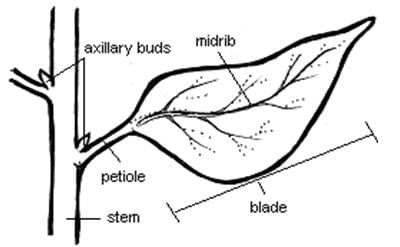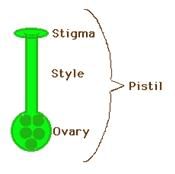Class 6 Science Chapter 4 Question Answers - Getting to know plants
Short Q & A:
Q1: What types of plants are called tress?
Ans: Plants which are tall and have hard, thick brown stem are called trees. The stem has branches in the upper part, much above the ground.
Q2: What is the difference between stem of shrubs and trees?
Ans: Stem in shrubs is hard but not very thick whereas trees have hard, thick brown stem.
Q3: What are creepers?
Ans: The plants with weak stem that cannot stand upright and spread on ground are called creepers.
Q4: What is the difference between creepers and climbers?
Ans: The plants with weak stem that cannot stand upright and spread on ground are called creepers. Whereas plants take support on neighbouring structures and climb up are called climbers.
Q5: Write the difference between reticulate and parallel venation. Give examples.
Ans: If the design made by veins in the leaf is net like on both side of mid rib, the venation is reticulate. E.g. rose. If the veins are parallel to each other, the venation is parallel. E.g. wheat.
Q6: What is photosynthesis?
Ans: Leaves prepare their food in presence of sunlight by using water and CO2.This is called photosynthesis.
Q7: Write any two functions of root?
Ans:
a) Roots help in holding plant firmly in the soil.
b) Roots help in absorption of water and minerals from the soil.
Q8: Draw a labelled diagram of leaf.
Ans:

Q9: Where is food stored in plant and in what form?
Ans: Food is stored in plant in leaves and in some plants in roots. Food is stored in plants in the form of starch.
Q10: What are the different types of root found in plant?
Ans: Some plants have a main root called tap root and smaller roots called lateral roots. Whereas other plants have fibrous roots.
Q11: Draw a labelled diagram to show different parts of pistil.
Ans: 
Q12: How are leaf venation and types of roots in a plant related?
Ans: Plants having the reticulate venation have tap roots while plants having the leaves with parallel venation have fibrous roots.
Q13: What is the function of stem in plant?
Ans: The stem conducts water from roots to the leaves (and other parts of plant) and food from leaves to other plant parts.
Q14: By which process plants prepare its food? And where it takes place?
Ans: Plants prepare its food by photosynthesis. It takes place in the leaves of plant.
Q15: In which part of flower ovary is found? What can be seen in innermost part of an ovary?
Ans: Ovary is found in pistil. Ovules can be seen in innermost part of an ovary.
Q16: Photosynthesis takes place in leaves. What do plants use for photosynthesis?
Ans: Plants use carbon dioxide and water for photosynthesis. It takes place in presence of sunlight and chlorophyll.
Q17: From where plant gets water?
Ans: Plants get water from soil through roots. It is conducted to all plant parts by stem.
Q18: Which are two gases involved in photosynthesis? How?
Ans: Carbon dioxide and oxygen are involved in photosynthesis. Carbon dioxide is used whereas oxygen is released in photosynthesis.
Q19: What is the function of ovary?
Ans: Fertilization takes place in ovary.
Long Q & A:
Q1: Draw a labelled diagram of a flower.
Ans:
FAQs on Class 6 Science Chapter 4 Question Answers - Getting to know plants
| 1. What are the different parts of a plant? |  |
| 2. How do plants obtain water and nutrients? |  |
| 3. What is photosynthesis and why is it important for plants? |  |
| 4. How do plants reproduce? |  |
| 5. Why are plants important for the environment and human beings? |  |

















